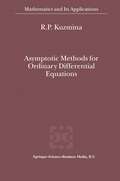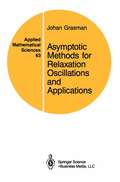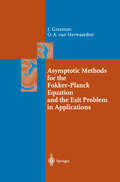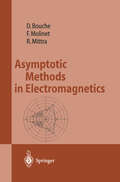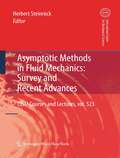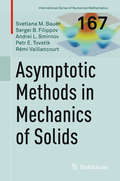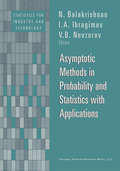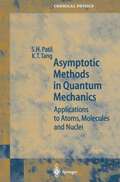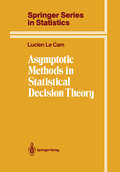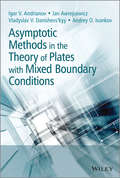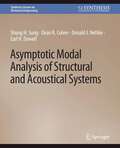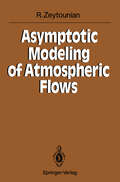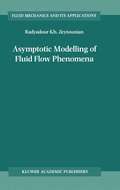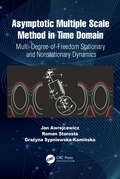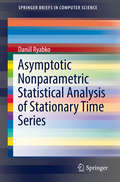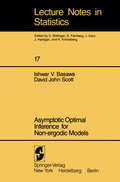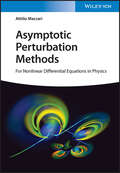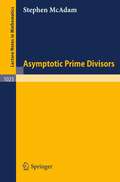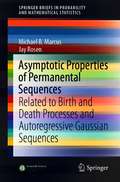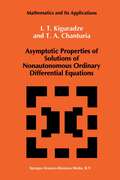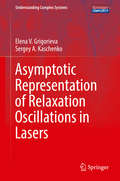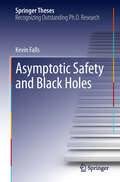- Table View
- List View
Asymptotic Methods for Ordinary Differential Equations (Mathematics and Its Applications #512)
by R.P. KuzminaIn this book we consider a Cauchy problem for a system of ordinary differential equations with a small parameter. The book is divided into th ree parts according to three ways of involving the small parameter in the system. In Part 1 we study the quasiregular Cauchy problem. Th at is, a problem with the singularity included in a bounded function j , which depends on time and a small parameter. This problem is a generalization of the regu larly perturbed Cauchy problem studied by Poincare [35]. Some differential equations which are solved by the averaging method can be reduced to a quasiregular Cauchy problem. As an example, in Chapter 2 we consider the van der Pol problem. In Part 2 we study the Tikhonov problem. This is, a Cauchy problem for a system of ordinary differential equations where the coefficients by the derivatives are integer degrees of a small parameter.
Asymptotic Methods for Relaxation Oscillations and Applications (Applied Mathematical Sciences #63)
by Johan GrasmanIn various fields of science, notably in physics and biology, one is con fronted with periodic phenomena having a remarkable temporal structure: it is as if certain systems are periodically reset in an initial state. A paper of Van der Pol in the Philosophical Magazine of 1926 started up the investigation of this highly nonlinear type of oscillation for which Van der Pol coined the name "relaxation oscillation". The study of relaxation oscillations requires a mathematical analysis which differs strongly from the well-known theory of almost linear oscillations. In this monograph the method of matched asymptotic expansions is employed to approximate the periodic orbit of a relaxation oscillator. As an introduction, in chapter 2 the asymptotic analysis of Van der Pol's equation is carried out in all detail. The problem exhibits all features characteristic for a relaxation oscillation. From this case study one may learn how to handle other or more generally formulated relaxation oscillations. In the survey special attention is given to biological and chemical relaxation oscillators. In chapter 2 a general definition of a relaxation oscillation is formulated.
Asymptotic Methods for the Fokker-Planck Equation and the Exit Problem in Applications (Springer Series in Synergetics)
by Johan Grasman Onno A., HerwaardenAsymptotic methods are of great importance for practical applications, especially in dealing with boundary value problems for small stochastic perturbations. This book deals with nonlinear dynamical systems perturbed by noise. It addresses problems in which noise leads to qualitative changes, escape from the attraction domain, or extinction in population dynamics. The most likely exit point and expected escape time are determined with singular perturbation methods for the corresponding Fokker-Planck equation. The authors indicate how their techniques relate to the Itô calculus applied to the Langevin equation. The book will be useful to researchers and graduate students.
Asymptotic Methods in Electromagnetics
by Daniel Bouche Frederic Molinet Raj MittraNumerically rigorous techniques for the computation of electromagnetic fields diffracted by an object become computationally intensive, if not impractical to handle, at high frequencies and one must resort to asymptotic methods to solve the scattering problem at short wavelengths. The asymptotic methods provide closed form expansions for the diffracted fields and are also useful for eliciting physical interpretations of the various diffraction phenomena. One of the principal objectives of this book is to discuss the different asymptotic methods in a unified manner. Although the book contains explicit formulas for computing the field diffracted by conducting or dielectric-coated objects, it also provides the mathematical foundations of the different methods and explains how they are interrelated.
Asymptotic Methods in Fluid Mechanics: Survey and Recent Advances (CISM International Centre for Mechanical Sciences #523)
by Herbert SteinrückA survey of asymptotic methods in fluid mechanics and applications is given including high Reynolds number flows (interacting boundary layers, marginal separation, turbulence asymptotics) and low Reynolds number flows as an example of hybrid methods, waves as an example of exponential asymptotics and multiple scales methods in meteorology.
Asymptotic methods in mechanics of solids (International Series of Numerical Mathematics #167)
by Svetlana M. Bauer Sergei B. Filippov Andrei L. Smirnov Petr E. Tovstik Rémi VaillancourtThe construction of solutions of singularly perturbed systems of equations and boundary value problems that are characteristic for the mechanics of thin-walled structures are the main focus of the book. The theoretical results are supplemented by the analysis of problems and exercises. Some of the topics are rarely discussed in the textbooks, for example, the Newton polyhedron, which is a generalization of the Newton polygon for equations with two or more parameters. After introducing the important concept of the index of variation for functions special attention is devoted to eigenvalue problems containing a small parameter. The main part of the book deals with methods of asymptotic solutions of linear singularly perturbed boundary and boundary value problems without or with turning points, respectively. As examples, one-dimensional equilibrium, dynamics and stability problems for rigid bodies and solids are presented in detail. Numerous exercises and examples as well as vast references to the relevant Russian literature not well known for an English speaking reader makes this a indispensable textbook on the topic.
Asymptotic Methods in Probability and Statistics with Applications (Statistics for Industry and Technology)
by N. Balakrishnan V. B. I. Ibragimov V. B. NevzorovTraditions of the 150-year-old St. Petersburg School of Probability and Statis tics had been developed by many prominent scientists including P. L. Cheby chev, A. M. Lyapunov, A. A. Markov, S. N. Bernstein, and Yu. V. Linnik. In 1948, the Chair of Probability and Statistics was established at the Department of Mathematics and Mechanics of the St. Petersburg State University with Yu. V. Linik being its founder and also the first Chair. Nowadays, alumni of this Chair are spread around Russia, Lithuania, France, Germany, Sweden, China, the United States, and Canada. The fiftieth anniversary of this Chair was celebrated by an International Conference, which was held in St. Petersburg from June 24-28, 1998. More than 125 probabilists and statisticians from 18 countries (Azerbaijan, Canada, Finland, France, Germany, Hungary, Israel, Italy, Lithuania, The Netherlands, Norway, Poland, Russia, Taiwan, Turkey, Ukraine, Uzbekistan, and the United States) participated in this International Conference in order to discuss the current state and perspectives of Probability and Mathematical Statistics. The conference was organized jointly by St. Petersburg State University, St. Petersburg branch of Mathematical Institute, and the Euler Institute, and was partially sponsored by the Russian Foundation of Basic Researches. The main theme of the Conference was chosen in the tradition of the St.
Asymptotic Methods in Quantum Mechanics: Application to Atoms, Molecules and Nuclei (Springer Series in Chemical Physics #64)
by S.H. Patil K.T. TangQuantum mechanics and the Schrodinger equation are the basis for the de scription of the properties of atoms, molecules, and nuclei. The development of reliable, meaningful solutions for the energy eigenfunctions of these many is a formidable problem. The usual approach for obtaining particle systems the eigenfunctions is based on their variational extremum property of the expectation values of the energy. However the complexity of these variational solutions does not allow a transparent, compact description of the physical structure. There are some properties of the wave functions in some specific, spatial domains, which depend on the general structure of the Schrodinger equation and the electromagnetic potential. These properties provide very useful guidelines in developing simple and accurate solutions for the wave functions of these systems, and provide significant insight into their physical structure. This point, though of considerable importance, has not received adequate attention. Here we present a description of the local properties of the wave functions of a collection of particles, in particular the asymptotic properties when one of the particles is far away from the others. The asymptotic behaviour of this wave function depends primarily on the separation energy of the outmost particle. The universal significance of the asymptotic behaviour of the wave functions should be appreciated at both research and pedagogic levels. This is the main aim of our presentation here.
Asymptotic Methods in Statistical Decision Theory (Springer Series in Statistics)
by Lucien Le CamThis book grew out of lectures delivered at the University of California, Berkeley, over many years. The subject is a part of asymptotics in statistics, organized around a few central ideas. The presentation proceeds from the general to the particular since this seemed the best way to emphasize the basic concepts. The reader is expected to have been exposed to statistical thinking and methodology, as expounded for instance in the book by H. Cramer [1946] or the more recent text by P. Bickel and K. Doksum [1977]. Another pos sibility, closer to the present in spirit, is Ferguson [1967]. Otherwise the reader is expected to possess some mathematical maturity, but not really a great deal of detailed mathematical knowledge. Very few mathematical objects are used; their assumed properties are simple; the results are almost always immediate consequences of the definitions. Some objects, such as vector lattices, may not have been included in the standard background of a student of statistics. For these we have provided a summary of relevant facts in the Appendix. The basic structures in the whole affair are systems that Blackwell called "experiments" and "transitions" between them. An "experiment" is a mathe matical abstraction intended to describe the basic features of an observational process if that process is contemplated in advance of its implementation. Typically, an experiment consists of a set E> of theories about what may happen in the observational process.
Asymptotic Methods in the Theory of Plates with Mixed Boundary Conditions
by Igor Andrianov Jan Awrejcewicz Vladyslav Danishevs'kyy Andrey IvankovAsymptotic Methods in the Theory of Plates with Mixed Boundary Conditions comprehensively covers the theoretical background of asymptotic approaches and their use in solving mechanical engineering-oriented problems of structural members, primarily plates (statics and dynamics) with mixed boundary conditions. The first part of this book introduces the theory and application of asymptotic methods and includes a series of approaches that have been omitted or not rigorously treated in the existing literature. These lesser known approaches include the method of summation and construction of the asymptotically equivalent functions, methods of small and large delta, and the homotopy perturbations method. The second part of the book contains original results devoted to the solution of the mixed problems of the theory of plates, including statics, dynamics and stability of the studied objects. In addition, the applicability of the approaches presented to other related linear or nonlinear problems is addressed. Key features: • Includes analytical solving of mixed boundary value problems • Introduces modern asymptotic and summation procedures • Presents asymptotic approaches for nonlinear dynamics of rods, beams and plates • Covers statics, dynamics and stability of plates with mixed boundary conditions • Explains links between the Adomian and homotopy perturbation approaches Asymptotic Methods in the Theory of Plates with Mixed Boundary Conditions is a comprehensive reference for researchers and practitioners working in the field of Mechanics of Solids and Mechanical Engineering, and is also a valuable resource for graduate and postgraduate students from Civil and Mechanical Engineering.
Asymptotic Methods in the Theory of Plates with Mixed Boundary Conditions
by Igor Andrianov Jan Awrejcewicz Vladyslav Danishevs'kyy Andrey IvankovAsymptotic Methods in the Theory of Plates with Mixed Boundary Conditions comprehensively covers the theoretical background of asymptotic approaches and their use in solving mechanical engineering-oriented problems of structural members, primarily plates (statics and dynamics) with mixed boundary conditions. The first part of this book introduces the theory and application of asymptotic methods and includes a series of approaches that have been omitted or not rigorously treated in the existing literature. These lesser known approaches include the method of summation and construction of the asymptotically equivalent functions, methods of small and large delta, and the homotopy perturbations method. The second part of the book contains original results devoted to the solution of the mixed problems of the theory of plates, including statics, dynamics and stability of the studied objects. In addition, the applicability of the approaches presented to other related linear or nonlinear problems is addressed. Key features: • Includes analytical solving of mixed boundary value problems • Introduces modern asymptotic and summation procedures • Presents asymptotic approaches for nonlinear dynamics of rods, beams and plates • Covers statics, dynamics and stability of plates with mixed boundary conditions • Explains links between the Adomian and homotopy perturbation approaches Asymptotic Methods in the Theory of Plates with Mixed Boundary Conditions is a comprehensive reference for researchers and practitioners working in the field of Mechanics of Solids and Mechanical Engineering, and is also a valuable resource for graduate and postgraduate students from Civil and Mechanical Engineering.
Asymptotic Modal Analysis of Structural and Acoustical Systems (Synthesis Lectures on Mechanical Engineering)
by Shung Sung Dean Culver Donald Nefske Earl DowellThis book describes the Asymptotic Modal Analysis (AMA) method to predict the high-frequency vibroacoustic response of structural and acoustical systems. The AMA method is based on taking the asymptotic limit of Classical Modal Analysis (CMA) as the number of modes in the structural system or acoustical system becomes large in a certain frequency bandwidth. While CMA requires both the computation of individual modes and a modal summation, AMA evaluates the averaged modal response only at a center frequency of the bandwidth and does not sum the individual contributions from each mode to obtain a final result. It is similar to Statistical Energy Analysis (SEA) in this respect. However, while SEA is limited to obtaining spatial averages or mean values (as it is a statistical method), AMA is derived systematically from CMA and can provide spatial information as well as estimates of the accuracy of the solution for a particular number of modes. A principal goal is to present the state-of-the-art of AMA and suggest where further developments may be possible. A short review of the CMA method as applied to structural and acoustical systems subjected to random excitation is first presented. Then the development of AMA is presented for an individual structural system and an individual acoustic cavity system, as well as a combined structural-acoustic system. The extension of AMA for treating coupled or multi-component systems is then described, followed by its application to nonlinear systems. Finally, the AMA method is summarized and potential further developments are discussed.
Asymptotic Modeling of Atmospheric Flows
by Radyadour Kh. ZeytounianThe present work is not exactly a "course", but rather is presented as a monograph in which the author has set forth what are, for the most part, his own results; this is particularly true of Chaps. 7-13. Many of the problems dealt with herein have, since the school year 1975-76, been the subject of a series of graduate lectures at the "Universire des Sciences et Techniques de Lille I" for students preparing for the "Diplome d'Etudes Ap profondies de Mecanique (option fluides)". The writing of this book was thus strongly influenced by the author's own conception of meteorology as a fluid mechanics discipline which is in a privi leged area for the application of singular perturbation techniques. It goes without saying that the modeling of atmospheric flows is a vast and complex problem which is presently the focal point of many research projects. The enonnity of the topic explains why many important questions have not been taken up in this work, even among those which are closely related to the subject treated herein. Nonetheless, the author thought it worthwhile for the development of future research on the modeling of atmospheric flows (from the viewpoint of theoretical fluid mechanics) to bring forth a book specifying the problems which have already been resolved in this field and those which are, as yet, unsolved.
Asymptotic Modelling of Fluid Flow Phenomena (Fluid Mechanics and Its Applications #64)
by Radyadour Kh. Zeytounianfor the fluctuations around the means but rather fluctuations, and appearing in the following incompressible system of equations: on any wall; at initial time, and are assumed known. This contribution arose from discussion with J. P. Guiraud on attempts to push forward our last co-signed paper (1986) and the main idea is to put a stochastic structure on fluctuations and to identify the large eddies with a part of the probability space. The Reynolds stresses are derived from a kind of Monte-Carlo process on equations for fluctuations. Those are themselves modelled against a technique, using the Guiraud and Zeytounian (1986). The scheme consists in a set of like equations, considered as random, because they mimic the large eddy fluctuations. The Reynolds stresses are got from stochastic averaging over a family of their solutions. Asymptotics underlies the scheme, but in a rather loose hidden way. We explain this in relation with homogenizati- localization processes (described within the §3. 4 ofChapter 3). Ofcourse the mathematical well posedness of the scheme is not known and the numerics would be formidable! Whether this attempt will inspire researchers in the field of highly complex turbulent flows is not foreseeable and we have hope that the idea will prove useful.
Asymptotic Multiple Scale Method in Time Domain: Multi-Degree-of-Freedom Stationary and Nonstationary Dynamics
by Jan Awrejcewicz Roman Starosta Grażyna Sypniewska-KamińskaThis book offers up novel research which uses analytical approaches to explore nonlinear features exhibited by various dynamic processes. Relevant to disciplines across engineering and physics, the asymptotic method combined with the multiple scale method is shown to be an efficient and intuitive way to approach mechanics. Beginning with new material on the development of cutting-edge asymptotic methods and multiple scale methods, the book introduces this method in time domain and provides examples of vibrations of systems. Clearly written throughout, it uses innovative graphics to exemplify complex concepts such as nonlinear stationary and nonstationary processes, various resonances and jump pull-in phenomena. It also demonstrates the simplification of problems through using mathematical modelling, by employing the use of limiting phase trajectories to quantify nonlinear phenomena. Particularly relevant to structural mechanics, in rods, cables, beams, plates and shells, as well as mechanical objects commonly found in everyday devices such as mobile phones and cameras, the book shows how each system is modelled, and how it behaves under various conditions. It will be of interest to engineers and professionals in mechanical engineering and structural engineering, alongside those interested in vibrations and dynamics. It will also be useful to those studying engineering maths and physics.
Asymptotic Multiple Scale Method in Time Domain: Multi-Degree-of-Freedom Stationary and Nonstationary Dynamics
by Jan Awrejcewicz Roman Starosta Grażyna Sypniewska-KamińskaThis book offers up novel research which uses analytical approaches to explore nonlinear features exhibited by various dynamic processes. Relevant to disciplines across engineering and physics, the asymptotic method combined with the multiple scale method is shown to be an efficient and intuitive way to approach mechanics. Beginning with new material on the development of cutting-edge asymptotic methods and multiple scale methods, the book introduces this method in time domain and provides examples of vibrations of systems. Clearly written throughout, it uses innovative graphics to exemplify complex concepts such as nonlinear stationary and nonstationary processes, various resonances and jump pull-in phenomena. It also demonstrates the simplification of problems through using mathematical modelling, by employing the use of limiting phase trajectories to quantify nonlinear phenomena. Particularly relevant to structural mechanics, in rods, cables, beams, plates and shells, as well as mechanical objects commonly found in everyday devices such as mobile phones and cameras, the book shows how each system is modelled, and how it behaves under various conditions. It will be of interest to engineers and professionals in mechanical engineering and structural engineering, alongside those interested in vibrations and dynamics. It will also be useful to those studying engineering maths and physics.
Asymptotic Nonparametric Statistical Analysis of Stationary Time Series (SpringerBriefs in Computer Science)
by Daniil RyabkoStationarity is a very general, qualitative assumption, that can be assessed on the basis of application specifics. It is thus a rather attractive assumption to base statistical analysis on, especially for problems for which less general qualitative assumptions, such as independence or finite memory, clearly fail. However, it has long been considered too general to be able to make statistical inference. One of the reasons for this is that rates of convergence, even of frequencies to the mean, are not available under this assumption alone. Recently, it has been shown that, while some natural and simple problems, such as homogeneity, are indeed provably impossible to solve if one only assumes that the data is stationary (or stationary ergodic), many others can be solved with rather simple and intuitive algorithms. The latter include clustering and change point estimation among others. In this volume I summarize these results. The emphasis is on asymptotic consistency, since this the strongest property one can obtain assuming stationarity alone. While for most of the problem for which a solution is found this solution is algorithmically realizable, the main objective in this area of research, the objective which is only partially attained, is to understand what is possible and what is not possible to do for stationary time series. The considered problems include homogeneity testing (the so-called two sample problem), clustering with respect to distribution, clustering with respect to independence, change point estimation, identity testing, and the general problem of composite hypotheses testing. For the latter problem, a topological criterion for the existence of a consistent test is presented. In addition, a number of open problems is presented.
Asymptotic Optimal Inference for Non-ergodic Models (Lecture Notes in Statistics #17)
by I. V. Basawa D. J. ScottThis monograph contains a comprehensive account of the recent work of the authors and other workers on large sample optimal inference for non-ergodic models. The non-ergodic family of models can be viewed as an extension of the usual Fisher-Rao model for asymptotics, referred to here as an ergodic family. The main feature of a non-ergodic model is that the sample Fisher information, appropriately normed, converges to a non-degenerate random variable rather than to a constant. Mixture experiments, growth models such as birth processes, branching processes, etc. , and non-stationary diffusion processes are typical examples of non-ergodic models for which the usual asymptotics and the efficiency criteria of the Fisher-Rao-Wald type are not directly applicable. The new model necessitates a thorough review of both technical and qualitative aspects of the asymptotic theory. The general model studied includes both ergodic and non-ergodic families even though we emphasise applications of the latter type. The plan to write the monograph originally evolved through a series of lectures given by the first author in a graduate seminar course at Cornell University during the fall of 1978, and by the second author at the University of Munich during the fall of 1979. Further work during 1979-1981 on the topic has resolved many of the outstanding conceptual and technical difficulties encountered previously. While there are still some gaps remaining, it appears that the mainstream development in the area has now taken a more definite shape.
Asymptotic Perturbation Methods: For Nonlinear Differential Equations in Physics
by Attilio MaccariAsymptotic Perturbation Methods Cohesive overview of powerful mathematical methods to solve differential equations in physics Asymptotic Perturbation Methods for Nonlinear Differential Equations in Physics addresses nonlinearity in various fields of physics from the vantage point of its mathematical description in the form of nonlinear partial differential equations and presents a unified view on nonlinear systems in physics by providing a common framework to obtain approximate solutions to the respective nonlinear partial differential equations based on the asymptotic perturbation method. Aside from its complete coverage of a complicated topic, a noteworthy feature of the book is the emphasis on applications. There are several examples included throughout the text, and, crucially, the scientific background is explained at an elementary level and closely integrated with the mathematical theory to enable seamless reader comprehension. To fully understand the concepts within this book, the prerequisites are multivariable calculus and introductory physics. Written by a highly qualified author with significant accomplishments in the field, Asymptotic Perturbation Methods for Nonlinear Differential Equations in Physics covers sample topics such as: Application of the various flavors of the asymptotic perturbation method, such as the Maccari method to the governing equations of nonlinear system Nonlinear oscillators, limit cycles, and their bifurcations, iterated nonlinear maps, continuous systems, and nonlinear partial differential equations (NPDEs) Nonlinear systems, such as the van der Pol oscillator, with advanced coverage of plasma physics, quantum mechanics, elementary particle physics, cosmology, and chaotic systems Infinite-period bifurcation in the nonlinear Schrodinger equation and fractal and chaotic solutions in NPDEs Asymptotic Perturbation Methods for Nonlinear Differential Equations in Physics is ideal for an introductory course at the senior or first year graduate level. It is also a highly valuable reference for any professional scientist who does not possess deep knowledge about nonlinear physics.
Asymptotic Perturbation Methods: For Nonlinear Differential Equations in Physics
by Attilio MaccariAsymptotic Perturbation Methods Cohesive overview of powerful mathematical methods to solve differential equations in physics Asymptotic Perturbation Methods for Nonlinear Differential Equations in Physics addresses nonlinearity in various fields of physics from the vantage point of its mathematical description in the form of nonlinear partial differential equations and presents a unified view on nonlinear systems in physics by providing a common framework to obtain approximate solutions to the respective nonlinear partial differential equations based on the asymptotic perturbation method. Aside from its complete coverage of a complicated topic, a noteworthy feature of the book is the emphasis on applications. There are several examples included throughout the text, and, crucially, the scientific background is explained at an elementary level and closely integrated with the mathematical theory to enable seamless reader comprehension. To fully understand the concepts within this book, the prerequisites are multivariable calculus and introductory physics. Written by a highly qualified author with significant accomplishments in the field, Asymptotic Perturbation Methods for Nonlinear Differential Equations in Physics covers sample topics such as: Application of the various flavors of the asymptotic perturbation method, such as the Maccari method to the governing equations of nonlinear system Nonlinear oscillators, limit cycles, and their bifurcations, iterated nonlinear maps, continuous systems, and nonlinear partial differential equations (NPDEs) Nonlinear systems, such as the van der Pol oscillator, with advanced coverage of plasma physics, quantum mechanics, elementary particle physics, cosmology, and chaotic systems Infinite-period bifurcation in the nonlinear Schrodinger equation and fractal and chaotic solutions in NPDEs Asymptotic Perturbation Methods for Nonlinear Differential Equations in Physics is ideal for an introductory course at the senior or first year graduate level. It is also a highly valuable reference for any professional scientist who does not possess deep knowledge about nonlinear physics.
Asymptotic Properties of Permanental Sequences: Related to Birth and Death Processes and Autoregressive Gaussian Sequences (SpringerBriefs in Probability and Mathematical Statistics)
by Michael B. Marcus Jay RosenThis SpringerBriefs employs a novel approach to obtain the precise asymptotic behavior at infinity of a large class of permanental sequences related to birth and death processes and autoregressive Gaussian sequences using techniques from the theory of Gaussian processes and Markov chains. The authors study alpha-permanental processes that are positive infinitely divisible processes determined by the potential density of a transient Markov process. When the Markov process is symmetric, a 1/2-permanental process is the square of a Gaussian process. Permanental processes are related by the Dynkin isomorphism theorem to the total accumulated local time of the Markov process when the potential density is symmetric, and by a generalization of the Dynkin theorem by Eisenbaum and Kaspi without requiring symmetry. Permanental processes are also related to chi square processes and loop soups. The book appeals to researchers and advanced graduate students interested in stochastic processes, infinitely divisible processes and Markov chains.
Asymptotic Properties of Solutions of Nonautonomous Ordinary Differential Equations (Mathematics and its Applications #89)
by Ivan Kiguradze T.A. ChanturiaThis volume provides a comprehensive review of the developments which have taken place during the last thirty years concerning the asymptotic properties of solutions of nonautonomous ordinary differential equations. The conditions of oscillation of solutions are established, and some general theorems on the classification of equations according to their oscillatory properties are proved. In addition, the conditions are found under which nonlinear equations do not have singular, proper, oscillatory and monotone solutions. The book has five chapters: Chapter I deals with linear differential equations; Chapter II with quasilinear equations; Chapter III with general nonlinear differential equations; and Chapter IV and V deal, respectively, with higher-order and second-order differential equations of the Emden-Fowler type. Each section contains problems, including some which presently remain unsolved. The volume concludes with an extensive list of references. For researchers and graduate students interested in the qualitative theory of differential equations.
Asymptotic Representation of Relaxation Oscillations in Lasers (Understanding Complex Systems)
by Elena V. Grigorieva Sergey A. KaschenkoIn this book we analyze relaxation oscillations in models of lasers with nonlinear elements controlling light dynamics. The models are based on rate equations taking into account periodic modulation of parameters, optoelectronic delayed feedback, mutual coupling between lasers, intermodal interaction and other factors. With the aim to study relaxation oscillations we present the special asymptotic method of integration for ordinary differential equations and differential-difference equations. As a result, they are reduced to discrete maps. Analyzing the maps we describe analytically such nonlinear phenomena in lasers as multistability of large-amplitude relaxation cycles, bifurcations of cycles, controlled switching of regimes, phase synchronization in an ensemble of coupled systems and others. The book can be fruitful for students and technicians in nonlinear laser dynamics and in differential equations.
Asymptotic Safety and Black Holes (Springer Theses)
by Kevin FallsOne of the open challenges in fundamental physics is to combine Einstein's theory of general relativity with the principles of quantum mechancis. In this thesis, the question is raised whether metric quantum gravity could be fundamental in the spirit of Steven Weinberg's seminal asymptotic safety conjecture, and if so, what are the consequences for the physics of small, possibly Planck-size black holes? To address the first question, new techniques are provided which allow, for the first time, a self-consistent study of high-order polynomial actions including up to 34 powers in the Ricci scalar. These novel insights are then exploited to explain quantum gravity effects in black holes, including their horizon and causal structure, conformal scaling, evaporation, and the thermodynamics of quantum space-time. Results indicate upper limits on black hole temperature, and the existence of small black holes based on asymptotic safety for gravity and thermodynamical arguments.
